Do you own a 1919 Wheat Penny and wonder how much it’s worth? Or are you considering adding one to your coin collection?
Wheat pennies are among the most collected coins in the Lincoln series, prized for both their sentimental and financial value. While most circulated coins hold only their face value, mint-state 1919 Wheat Pennies can be worth hundreds or even thousands of dollars. Additionally, error coins can fetch even higher prices.
This 1919 Wheat Penny Value Guide will help you understand the worth of this classic coin and whether it’s a worthwhile investment.
1919 Wheat Penny Value Chart
| Mint Mark | Good | Fine | Extremely Fine | Uncirculated |
|---|---|---|---|---|
| 1919 (No Mint Mark) | $0.29 | $0.41 | $3.79 | $29 |
| 1919-D | $1.20 | $2.41 | $12 | $149 |
| 1919-S | $0.59 | $1.82 | $7.05 | $139 |
Would you like to learn more about specific errors, grading details, or auction records for the 1919 Wheat Penny?
History of the Wheat Penny
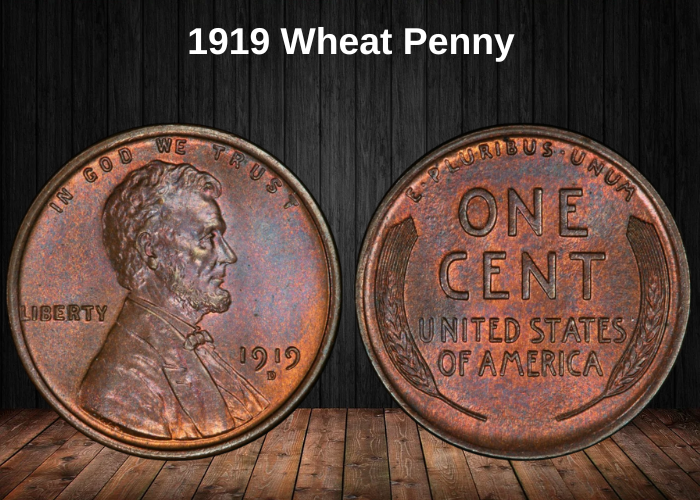
The Wheat Penny was first minted in 1909 to honor the 100th anniversary of Abraham Lincoln’s birth. It became the first widely circulated U.S. coin to depict a former president on its obverse. The reverse design featured two wheat stalks, which gave rise to the coin’s popular nickname, Wheat Penny or Wheaties.
President Theodore Roosevelt played a key role in its creation. He had long desired a redesign of several U.S. coins, including the one-cent piece.
In 1908, Roosevelt had a sitting with Victor David Brenner, the sculptor behind the Panama Canal Commission medal. While the exact details of their conversation remain unknown, many believe Roosevelt encouraged Brenner to consider designing a Lincoln-themed coin.
Shortly after, Frank Leach, the U.S. Mint director, officially commissioned Brenner to work on the Lincoln Penny. After several design adjustments, the final version was approved, and the Wheat Penny was released on August 2, 1909.
Originally, Brenner included his initials (VDB) prominently on the coin, but this caused controversy, leading the Mint to remove them shortly after production began. However, a few VDB pennies had already entered circulation before the change. In 1918, the initials were restored, but this time they were placed discreetly at the bottom of Lincoln’s shoulder. These VDB coins are now considered rare and highly collectible.
The Features of the 1919 Wheat Penny
The Obverse of the 1919 Wheat Penny
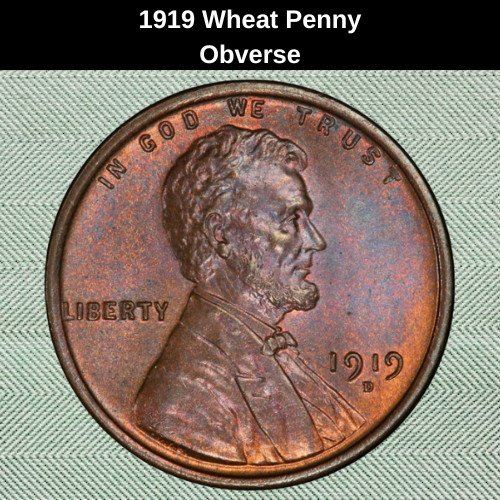
The obverse of the 1919 Wheat Penny features a right-facing portrait of Abraham Lincoln, the 16th President of the United States.
Along the upper edge of the coin, you’ll see the national motto, IN GOD WE TRUST. To Lincoln’s left, behind his shoulder, is the word LIBERTY, while the date “1919” is inscribed to his right.
If you examine the coin closely, you’ll spot the initials VDB at the cutoff of Lincoln’s shoulder near the rim. These initials—representing Victor David Brenner, the coin’s designer—were reintroduced in 1918 and are also present on the 1919 Wheat Penny.
The Reverse of the 1919 Wheat Penny
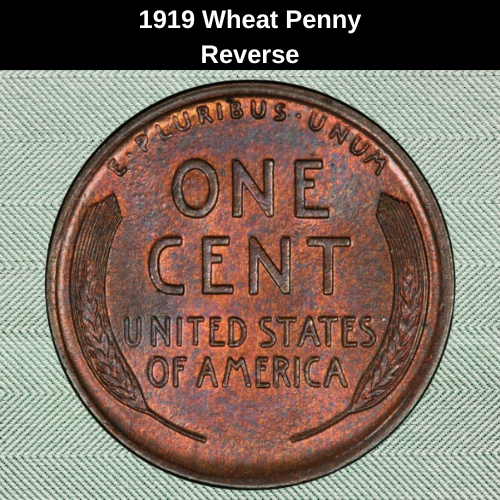
The reverse of the 1919 Wheat Penny showcases two wheat ears, one on each side of the coin. These distinctive wheat stalks are the inspiration behind the nickname “Wheat Penny.”
Along the top rim, you’ll find the Latin motto E PLURIBUS UNUM. At the center, between the wheat ears, the coin’s denomination is prominently displayed as ONE CENT, with UNITED STATES OF AMERICA inscribed just below it.
Other Features of the 1919 Wheat Penny
The 1919 Lincoln Wheat Penny is made of 95% copper with a 5% alloy of zinc and tin. It has a weight of 3.11 grams and a diameter of 19.00 millimeters.
Both the obverse and reverse were crafted by Victor David Brenner. His VDB initials can be spotted on the coin. Additionally, some pennies feature a “D” or “S” mint mark on the obverse, indicating they were struck in Denver or San Francisco, respectively.
Pennies minted in Philadelphia in 1919 do not have a mint mark.
1919 Wheat Penny Grading
Grading a 1919 Wheat Penny involves carefully assessing its condition and determining the extent of wear and tear.
- Circulated pennies typically hold modest value, often close to their face value.
- Uncirculated pennies, on the other hand, are highly desirable, showing no visible wear, even after decades.
How to Grade a 1919 Wheat Penny
- Use a loupe to check Lincoln’s jaw and cheek—there should be no dullness or wear.
- Luster and gloss are essential in uncirculated coins. A red surface is ideal, but minor browning is acceptable as long as the coin remains wear-free.
- Pay attention to:
- Lincoln’s eye and beard—should be sharp and unworn.
- Coat details—especially the front edge, which should retain its luster.
- Reverse side—the “ONE CENT” text should exhibit a frosty appearance, with luster on the coin’s field.
Wheat Penny Grading Scale
| # | Grade |
|---|---|
| 1 | Basal State-1 |
| 2 | Fair |
| 3 | Very Fair |
| 4-6 | Good |
| 7-10 | Very Good |
| 12-15 | Fine |
| 20-30 | Very Fine |
| 40 | Extremely Fine |
| 50 | About Uncirculated |
| 60 | Mint State |
| 65 | Mint State |
| 70 | Mint State (Perfect Condition) |
Check our grading guides to accurately determine the exact value of your 1919 Wheat Penny!
1919 Wheat Penny Value Guide
In this section, we will determine if a 1919 wheat penny holds any significant value. There are three varieties of this penny:
- 1919 no mint mark wheat penny (struck in Philadelphia)
- 1919-D wheat penny (struck in Denver)
- 1919-S wheat penny (struck in San Francisco)
Let’s now look at the value of each of these coins.
1919 No-Mint Mark Wheat Penny Value
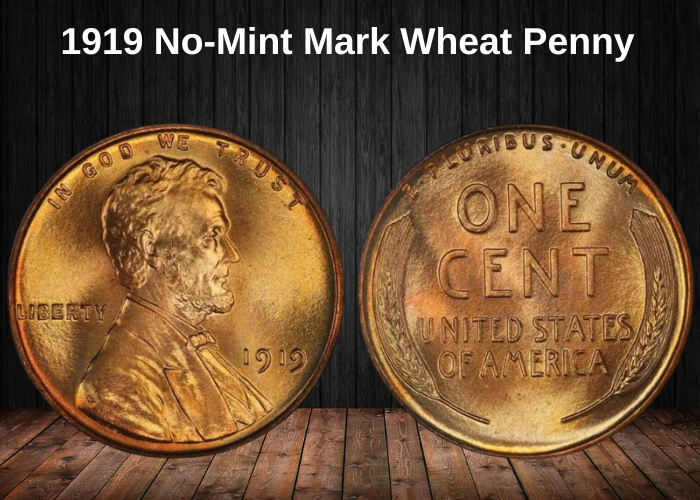
In 1919, the Philadelphia Mint struck a record 392,021,000 wheat pennies, setting one of the highest early mintage records, only surpassed by the 1940 wheat penny mintage.
Given the large number of coins produced and released into circulation, the 1919 no-mint mark wheat pennies are quite common, and you may still come across them in circulation today.
Because of their high mintage and widespread availability, these coins tend to have a lower value. In circulated condition, a 1919 no-mint mark wheat penny can range in value from $0.20 to $10, depending on its condition.
These coins are generally affordable and accessible in mint state as well. A 1919 penny graded MS60 with some minor scratches and contact marks may fetch around $30, while a gem-quality MS67 coin can sell for as much as $1,750.
The most expensive red color 1919 no-mint mark wheat penny, graded MS68, was sold for an impressive $18,500 at a 2018 Heritage auction.
Red wheat pennies are highly sought after due to their bright luster, minimal contact marks, and the absence of significant wear, making them more valuable than their brown and red-brown counterparts.
1919-S Wheat Penny Value
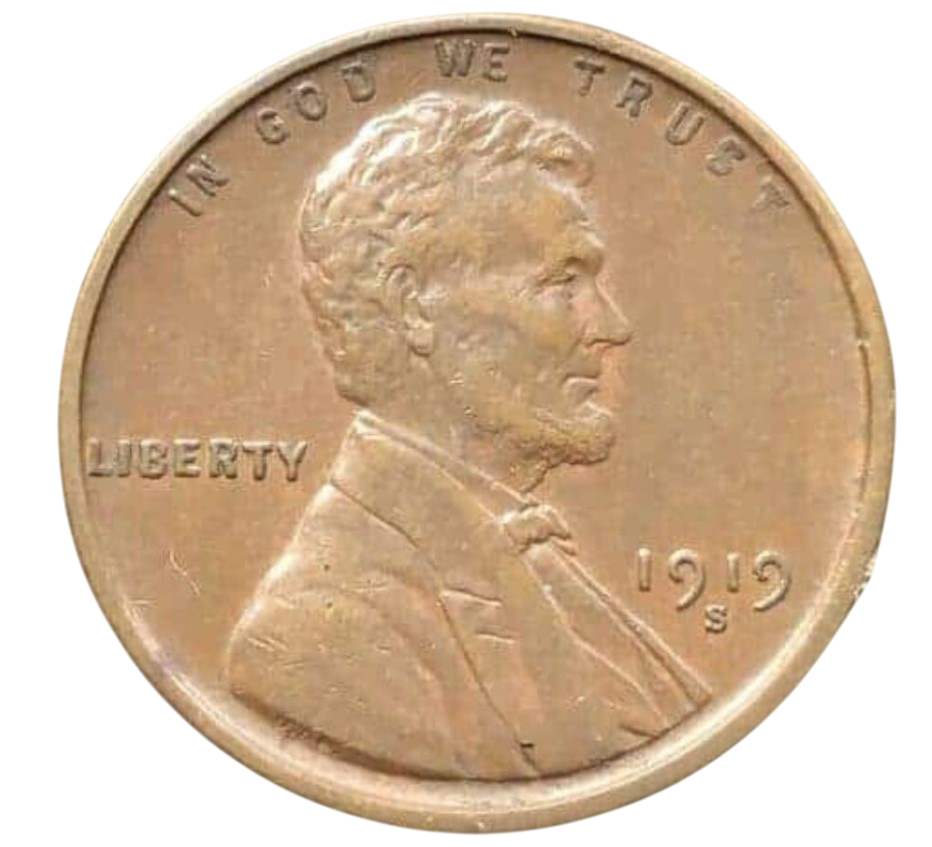
In 1919, the San Francisco Mint struck about 139,760,000 wheat pennies, making it the second-highest mintage that year.
Despite the high mintage, these coins remain relatively common, and you may still encounter them in circulation today. However, finding gem-quality 1919-S wheat pennies can be quite challenging due to the use of poor-quality dies at the San Francisco Mint, which resulted in coins with weak strikes.
Additionally, in 1919, there were fewer collectors dedicated to preserving wheat pennies, meaning that many of the coins found today are worth around their face value.
In circulated condition, a 1919-S wheat penny is typically worth around $0.35. However, the value can rise significantly for coins in better condition. For example, a 1919-S penny graded About Uncirculated (AU) 58 could be valued at around $45.
1919-D Wheat Penny Value
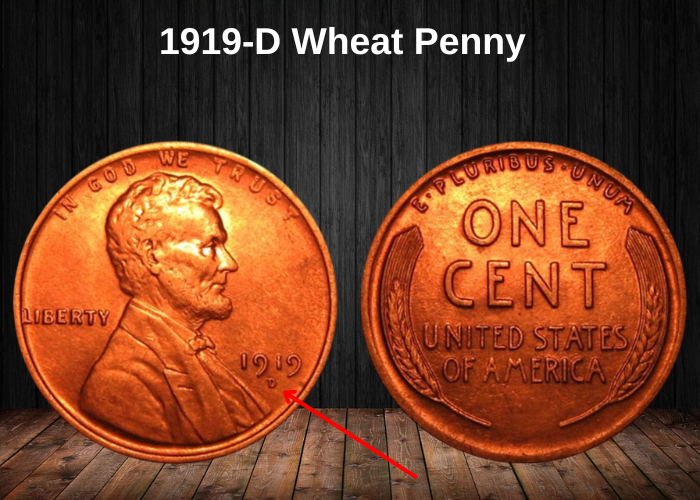
The Denver Mint struck the fewest number of wheat pennies in 1919, with a mintage of 57,154,000. This relatively low mintage makes 1919-D wheat pennies scarcer compared to those minted at the Philadelphia and San Francisco facilities.
Despite the smaller mintage, the 1919-D wheat penny remains the highest mintage coin produced by the Denver facility until the record was surpassed by the 1940 wheat penny.
In circulated condition, a 1919-D wheat penny is typically worth around $0.35. However, its value increases significantly for higher-grade coins. For example, a 1919-D penny graded AU58 can be worth around $55.
At a grade of MS67, a brown 1919-D penny can fetch as much as $37,500. If the coin is red-brown, it can still command a value of about $1,950 at the same grade. The red gem-quality 1919-D penny, however, can sell for $37,500, making it a highly sought-after collector’s item.
Rare 1919 Wheat Penny Errors List
1919 L on Rim Doubled-Die Obverse Wheat Penny Error
The 1919 wheat penny in question features two significant errors:
- L on LIBERTY struck on top of the rim: This error occurs when the die presses the letter “L” from the word “LIBERTY” onto the rim of the coin rather than on the coin’s surface. This misalignment makes the coin highly collectible.
- Doubled-die error: This is visible on the word “LIBERTY” and the date “1919”. The error happens when the die strikes the coin multiple times at slightly different angles, creating an overlapping or “doubling” effect on the lettering and numbers.
Collectors highly value such error coins, and a 1919 wheat penny with the L on rim and doubled-die obverse error can fetch as much as $265 in the marketplace due to its rarity and unique characteristics.
1919 Misaligned Die Wheat Penny Error
A misaligned die error occurs when the die used to strike the coin is not properly aligned with the coin’s surface, leading to a partially rotated design. This misalignment can cause the design to be struck at various angles, such as 30, 60, 90, 180, and in rare cases, even 360 degrees.
For the 1919 wheat penny, this error is particularly noticeable, and because of its unique appearance, such coins are highly sought after by collectors. A misaligned die error on a 1919 wheat penny can easily fetch up to $200, with higher prices for coins in mint state or in exceptional condition. The rarity and visual appeal of this error can significantly increase its value.
1919 Obverse Lamination Crack Wheat Penny Error
A lamination error occurs when small pieces of metal peel off the surface of a coin or planchet. This usually happens due to impurities or inconsistencies in the metal during the minting process, causing weak spots where the metal flakes off.
For a 1919 wheat penny with a lamination crack on the obverse, the coin can be worth around $110, though this value can increase based on the extent of the crack and the condition of the coin. The more pronounced the crack or the better the overall condition of the coin, the higher the price it could command from collectors.
1919 Un-centered Broadstrike Wheat Penny Error
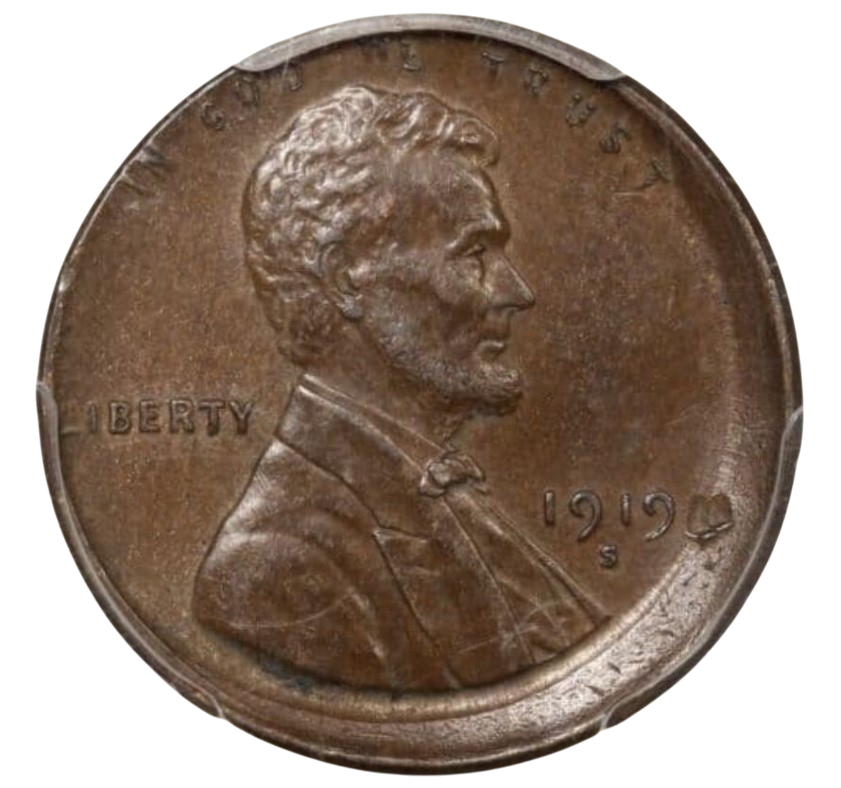
A broadstrike error occurs when the punching die strikes a coin outside of its collar. The collar is a key part of the coin-minting process as it holds the coin in place, ensuring it maintains the proper diameter during the strike. When a broadstrike happens, the coin ends up appearing wider than normal.
In the case of an uncentered broadstrike error, the design gets struck outside of the collar and is misaligned, making it off-center.
For a 1919 wheat penny with this type of uncentered broadstrike error, collectors may be willing to pay as much as $235, depending on its condition and the severity of the error.
Where to sell your penny?
Now that you know the value of your penny, you might be wondering where to sell it. Don’t worry: here’s a guide to some of the best online platforms where you can easily sell your coins, along with their advantages and disadvantages.
Discover the best platforms for selling coins online (pros and cons).
FAQ
What makes a 1919 wheat penny rare?
The 1919 wheat pennies are not inherently rare because millions were struck by the U.S. Mint, and they can still be found in circulation today. However, certain 1919 Lincoln wheat pennies are considered rare due to significant errors such as broadstrike and doubled-die errors. While most 1919 pennies were well-struck, finding one with such errors is uncommon. If you come across a 1919 wheat penny with an error, it could be worth significantly more.
Is a 1919 wheat penny worth a lot of money?
A 1919 wheat penny in circulated condition is generally worth its face value or only a small amount more, depending on its grade. However, if the coin is in mint condition, especially with red coloring, it can be worth hundreds to thousands of dollars. Non-mint state 1919 pennies are typically affordable for new collectors and investors.
What is a 1919 wheat penny made of?
A 1919 wheat penny is composed of 95% copper and 5% zinc and tin alloy. This composition remained the standard until the 1940s when the U.S. Mint switched to zinc-plated steel for pennies. In the 1980s, the penny’s composition was further altered to a copper-plated zinc mixture.


















































